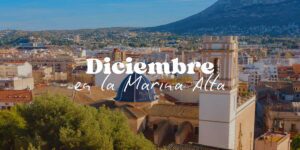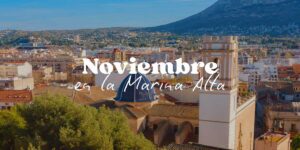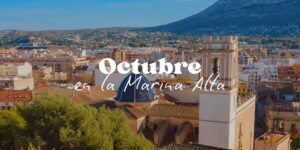June in Xàbia smells of gunpowder, sounds of charanga and tastes of beans and beans. The Fogueres de Sant Joan are not just any old fiestas: they are an explosion of tradition, identity and youth that turns every corner of the town into a vibrant stage. Beyond the fireworks and the cremà, these festivities hide decades of history, popular culture and a way of celebrating life that is very much our own. Today, we dive into the traditions of Sant Joan in Xàbia, from its origins to the most current customs, without forgetting the costumes, the music and the typical gastronomy that make them unforgettable.
Popular origins and Fallas spirit
The festivities of San Juan in Xàbia began in 1949, inspired by the passion aroused by the Fallas in Valencia. A group of young people, with more enthusiasm than means, decided to plant the first bonfires and give shape to the festivities that are now part of the Xabiera identity. A year later, in 1950, the first official edition of Les Fogueres was held, with an organising commission, monuments, queen and children’s commission.
To finance all this, creativity was key: the mythical Fiestas en el Aire were born, musical and theatrical evenings in the Espinós Cinema where neighbours of all ages participated as improvised artists. Popular culture in its purest form.
Costumes: the elegance of tradition
From the very beginning, clothing has played a leading role in the Fogueres. The first Fogueres women rented their Valencian costumes for 20 pesetas. Today, both the queens and the ladies and many locals proudly wear traditional dress: embroidered costumes, mantillas, elaborate hairstyles and accessories that speak of roots and craftsmanship.
But it is not all about tradition: there is also room for etiquette and glamour. One of the most eagerly awaited moments is the Gala Dinner of the Quintos, where the young people who turn 18 dress up and parade as if it were a catwalk. It is their big night, the prelude to all that is to come.
Music that envelops everything
The Fogueres cannot be understood without music. From the brass bands that accompany each parade, to the concerts, the open-air dances and the singing of the Fogueres anthem, music is the soul of the fiesta. The lyrics of the hymn speak of flowers, bonfires, beautiful women and skies tinged with palm trees (of fire, of course). Each verse encapsulates the essence of these fiestas: passion, joy, community.
One of the most magical moments is when, after the proclamation from the balcony of the Town Hall, the whole town sings the hymn through the streets, accompanied by the charanga, stopping in front of the religious images in niches and reliving a popular liturgy full of emotion.
Gastronomy: brevas, toasted beans and a lot of street food
Although there is no official Fogueres menu, there are flavours that are always present. During the Nit dels Focs, one of the most magical nights, people dance around small fires that symbolise the purification of the solstice while eating faves torrades (toasted beans) and handing out raïms i bacores (grapes and figs). It is the night of fire, dance, ancestral tradition and simple but symbolic flavours.
In addition, during the festivities there is no shortage of popular dinners in the Plaza de la Constitución, the peñas’ lunches, fairground sandwiches and fresh horchata (tiger nut milk). The street becomes a great dining room, a continuous celebration where sharing a table is also sharing history.
Events that say it all
The calendar of Les Fogueres is full of events that perfectly sum up the traditions of Sant Joan in Xàbia:
- The Proclamation of the Queen and her court, the symbolic start of the festivities.
- The Pregó, from the balcony of the Town Hall, with an invitation to the people to let themselves be carried away.
- The Entrà de bous, symbol of the popular and rural festival.
- The floral offering, where the religious fervour mixes with the emotion of the quintos.
- Parades, cavalcades, floats, mascletaes and open-air dances, each with its own particular identity.
And of course, the Cremà, which bids farewell to the fiestas amidst fire, tears and applause, closing one cycle and at the same time lighting the beginning of the next.
Youth, clubs and community
Since the 1980s, the real protagonists of the fiestas have been the quintos and quintas, boys and girls who turn 18 that year and form a ‘Quintà’. They elect their representatives, organise events, participate in all the events and keep the flame of Les Fogueres alive. The penyes are also essential: associations of friends who set up casales, collaborate in the programme and fill each day with colour and humour.
Xàbia in Sant Joan is not just a place to celebrate: it is a town that transforms itself, that remembers where it comes from, that honours its traditions and that continues to add generations to a festival that never stops evolving.
Because the Fogueres are not seen: they are lived
The traditions of Saint John’s Day in Jávea are not just calendar events or festive heritage. They are a way of understanding the summer, the community and the Xabiera identity. They are that moment when the fire cleans, the music unites and the brews taste better because they are eaten with hands stained with ashes.
The best thing of all? You don’t have to be born in Xàbia to feel it as your own. You just have to let yourself be carried away by the rhythm of the charanga, dance a dansà by the fire, or get excited to see a queen proclaimed under a sky of stars and firecrackers.
That’s why, if you want to enjoy this unique experience, we recommend you to book your accommodation with us. At Riu Rau Rentals we offer you private tourist accommodation on the Costa Blanca at the best price and with no extra commissions! Book directly on our website and start living the Fogueres like a ‘xabiero’.






